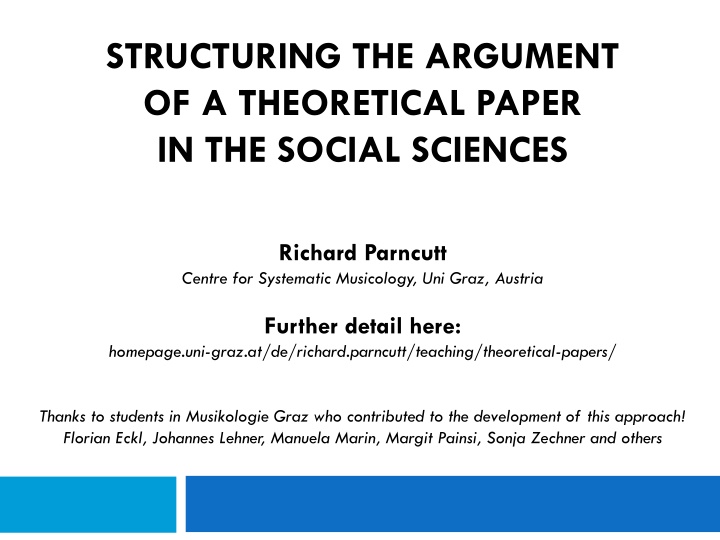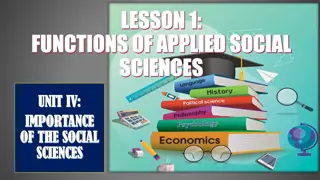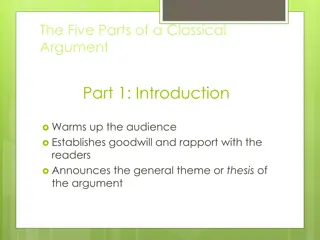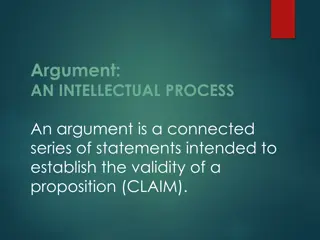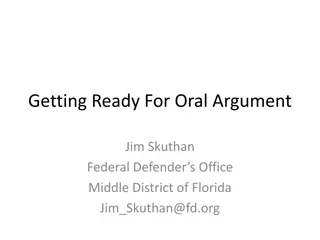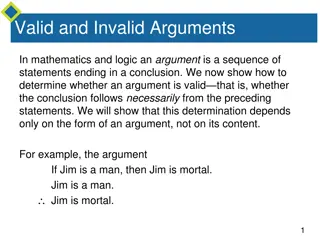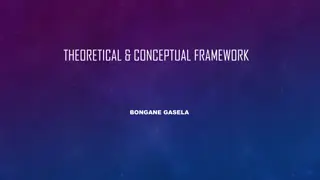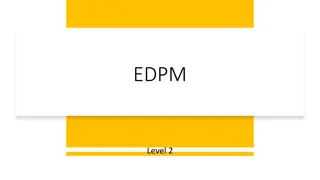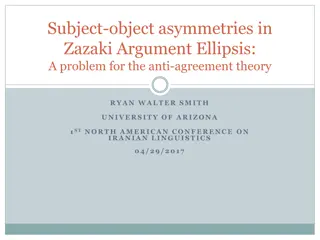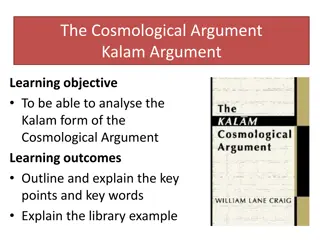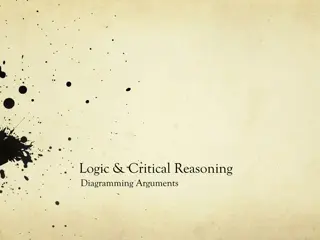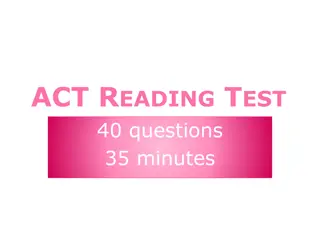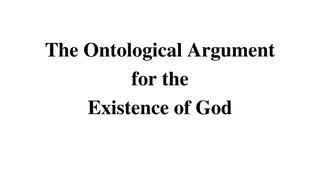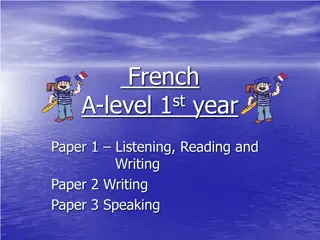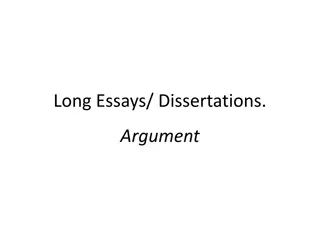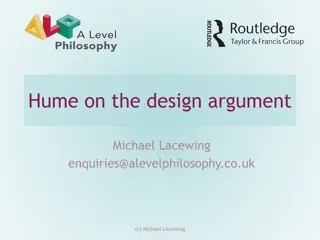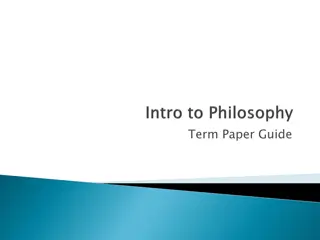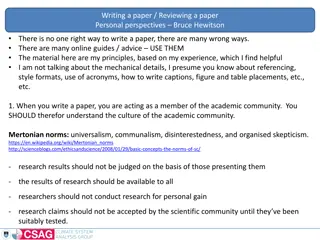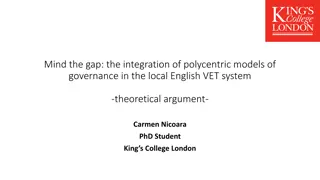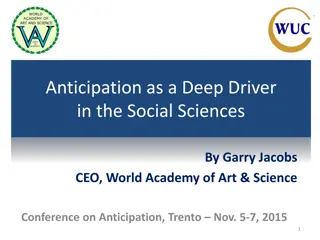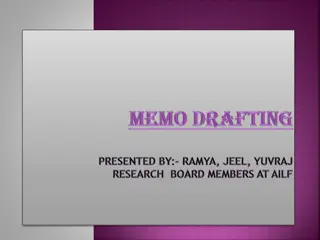Structuring the Argument of a Theoretical Paper in Social Sciences
Explore the key components of structuring a theoretical paper in the social sciences, emphasizing critical thinking, clarity, and complex argumentation. Delve into examples from music psychology, discussing unclear questions and the main thesis focused on applying critical thinking principles to research.
Download Presentation

Please find below an Image/Link to download the presentation.
The content on the website is provided AS IS for your information and personal use only. It may not be sold, licensed, or shared on other websites without obtaining consent from the author.If you encounter any issues during the download, it is possible that the publisher has removed the file from their server.
You are allowed to download the files provided on this website for personal or commercial use, subject to the condition that they are used lawfully. All files are the property of their respective owners.
The content on the website is provided AS IS for your information and personal use only. It may not be sold, licensed, or shared on other websites without obtaining consent from the author.
E N D
Presentation Transcript
STRUCTURING THE ARGUMENT OF A THEORETICAL PAPER IN THE SOCIAL SCIENCES Richard Parncutt Centre for Systematic Musicology, Uni Graz, Austria Further detail here: homepage.uni-graz.at/de/richard.parncutt/teaching/theoretical-papers/ Thanks to students in Musikologie Graz who contributed to the development of this approach! Florian Eckl, Johannes Lehner, Manuela Marin, Margit Painsi, Sonja Zechner and others
Critical thinking clear, careful, complex, constructive, collegial, caring, courageous credible! Most important thing taught at university? Ability To approach any issue in any discipline To apply current knowledge to new questions and create knowledge To become independent and find your voice As important as content foundations, literature, methods Important part of democracy E.g. political advertising before election campaigns Further info: Wikipedia on Critical thinking
Unclear questions, unclear answers some examples from music psychology How should we manage this uncertainty? evolutionary function of music nature of musical talent, emotion perceptual status of roots, tonics effect of music on intelligence trance, ecstasy, peak experiences, flow association between music and spirituality music, migration, integration, identity
The main thesis of this talk Students should learn general principles of critical thinking argumentation theory development and apply them to their own research
What is a good academic paper? What is a good bachelor, master or doctoral thesis? Peer review obey the current rules (Salieri?) Citation frequency predict future issues (Mozart?) 1. 2. Most people consider 1. Here, we talk about 2. What are the big questions? Which surprising answers might be true ?
Three elements of an argument that comprise almost the same words Verb? Question mark? no no Question yes Thesis Yes Topic yes no Example Topic: Question: How did music originate? Thesis: Music originated in social interaction The origins of music
Thesis and Subtheses Convergent evidence for your thesis Topic: Origin of music Question: How did music start in prehistory? Thesis: Music originated in social interaction Subtheses: Music originated in ritual Music promotes empathy Music is important for human reproduction
Subtheses: Convergent evidence Subthesis 2 Thesis Subthesis 3 Subthesis 1 Subthesis 4
Subtheses in everyday life People often talk like this: "I believe that explanation X is the best answer to question Y, for the following reasons: 1, 2 and 3. This is how we think logically! I believe thesis Reasons subtheses
Exercise Fill the gaps for your own current seminar paper or thesis (or any other topic) Topic: Main question: Main thesis: Subtheses:
Formulating a thesis It s harder than you think 1. Explore Collect some good publications in a topic area Find relevant claims in the literature and list them An example of a hermeneutic cycle: 2. Believe Choose a claim that you believe to be true But others may disagree. Your belief will motivate you to investigate it. 3. Convince Find arguments for and against your claim Do the arguments convince you? Other people? https://garyborjesson.wordpress.com If you/they are not convinced, return to 1 or 2! Go around the cycle several times!
Complex versus trivial theses of theoretical papers Too simple: X and Y are different Only two possibilities: same or different This is only interesting if we describe how they are different Cf. 2-tailed test - only interesting if we report direction Better: X is better than Y (directional) E.g. Music makes you happier than sport (???) But this thesis still contains only 1 bit of information Best: many possibilities (how/why questions) Cf. Likert scale (many answers) versus 2AFC (yes/no) how or why question ( multidimensional answer)
Subtheses should be: Relevant: Support main thesis Diverse: Address different (non-overlapping) aspects of main topic - as different as possible Plausible: supported by arguments and evidence that are stronger than counterarguments and - evidence Convergent evidence convince experts!
Abstract structure: A guideline Almost the same as the structure of the paper itself Introductory sentence Main question, main thesis (first subtopic:) first subthesis (second subtopic:) second subthesis (third subtopic:) third subthesis Main counterargument and rebuttal Implications if the main thesis is correct
Abstract: Example Universities are funded from various sources, including tuition fees. But university students should not have to pay fees. Fees can prevent poorer students from studying. Societies with lower wealth gaps are happier (more peaceful, healthier) than societies with higher wealth gaps. The general public gets a good return on long-term investment in universities. Universities can be publicly funded if tax havens are closed, progressive tax enforced, and wealth, environment and transaction taxes introduced. Students may be more motivated to study if they have to pay for the privilege, but students can also be motivated by adjusting challenges to skills, to increase the sense of achievement.
Abstract structure: Example Exercise: Formulate a title for this Introduction. Universities are funded from various sources, including tuition fees. Main thesis. Students should not have to pay fees. Subthesis 1: Social justice. Fees can prevent poorer students from studying. Subthesis 2: Social well-being. Societies with lower wealth gaps are more peaceful and healthier than societies with higher wealth gaps. Subthesis 3: Universities as long-term social investment. The general public gets a good return on investment in universities. Subthesis 4: Taxation. Universities can be publicly funded if tax havens are closed, progressive tax enforced, and wealth, environment and transaction taxes introduced. Counterargument. Paying students may be more motivated to study. Rebuttal. Students can be motivated by adjusting challenges to skills.
Psychological foundations of consonance and dissonance in music The structure of tonal Western music depends on consonance: dissonances resolve onto consonances with specific voice-leading patterns. How can we explain consonance psychologically? Musical consonance is a combination of several elements. First, musical sonorities are more consonant if they sound less rough - if there is less peripheral interaction between partials falling in the same critical band. Second, musical sonorities are more consonant if their spectra are more similar to a harmonic series. Third, musical sonorities are more consonant if they are more familiar to the listener. Fourth, the consonance of a musical passage depends on relationships between successive sonorities. One of these factors may be dominant in a given situation (for example, familiarity for modern listeners), but when history is considered, there is no clear evidence for one main factor. It follows that traditional Pythagorean ratio-based concepts of consonance should be abandoned.
Psychological foundations of consonance and dissonance in music Introduction. The structure of tonal Western music depends on consonance: dissonances resolve onto consonances with certain voice-leading patterns. Main question. How can we explain consonance psychologically? Main thesis. Musical consonance is a combination of several elements. Subtheses. First, musical sonorities are more consonant if they sound less rough - if there is less peripheral interaction between partials falling in the same critical band. Second, musical sonorities are more consonant if their spectra are more similar to a harmonic series. Third, musical sonorities are more consonant if they are more familiar to the listener. Fourth, the consonance of a musical passage depends on relationships between successive sonorities. One of these factors may be dominant in a given situation (for example, familiarity for modern listeners), but when history is considered, there is no clear evidence for one main factor. Implications. On this basis, traditional Pythagorean ratio-based concepts of consonance should be abandoned.
Abstract: example Current global warming is the most serious problem in all of history. The main cause is anthropogenic greenhouse gases. Apart from well- understood fluctuations, global mean temperature has risen steadily since humans started burning fossil fuels. Recent natural influences on long-term global mean temperature were smaller than human influences. Successful models of global temperature history combine several factors, of which anthropogenic emissions is the biggest. A model of thermal capacity of oceans, crust and atmosphere can explain the emissions-temperature relationship. Almost all qualified climate scientists agree that global warming is caused by humans. Many are skeptical about global warming because they cannot perceive it, but research shows the effects are already serious. Urgent and radical political action is required to prevent global warming exceeding 2 C later this century.
Abstract structure: Example Exercise: Formulate a title for this Introduction. Current global warming is the most serious problem in all of history. Main thesis. The main cause is anthropogenic greenhouse gases. 1st subtopic (temperature data). Apart from well-understood fluctuations, global mean temperature has risen steadily since humans started burning fossil fuels. 2nd subtopic (influences on global mean temperature). Recent natural influences on long-term global mean temperature were smaller than human influences. 3rd subtopic (modeling results). Successful models of global temperature history combine several factors, of which anthropogenic emissions is the biggest. 4th subtopic (magnitude of temperature increase). A model of thermal capacity of oceans, crust and atmosphere can explain the emissions-temperature relationship. 5th subtopic (role of expertise). Almost all qualified climate scientists agree that global warming is caused by humans; there is no reason to expect bias. Counterargument and rebuttal. Many are skeptical about global warming because they cannot perceive it, but research shows the effects are already serious. Implications. Urgent and radical political action is required to prevent global warming exceeding 2 C later this century.
What motivates music practice? Exercise: Formulate a title for this Children vary considerably in their motivation to play a musical instrument, which in turn determines whether they will become musicians or what standard they will achieve. What can account for this variability? The main source of motivation may not lie in the music itself or in the child's personality or physiology; instead, it may come from role models. Parents can be important role models if they regularly sing and play music themselves, and the child experiences their enjoyment of this activity. Much the same goes for siblings and peers: friends and acquaintances both at school and outside of school. There is also evidence of motivation from the emotional reward of the musical sounds themselves; that certain personality types are more likely to want to play music; and that the brains of children who play music are different from the start. However, the evidence for these alternatives is weaker. It follows that, if parents or teachers want their children or pupils to engage in music, they must do so themselves, and genuinely enjoy doing so.
Exercise Analyse abstracts found in Google Scholar Clearly structured? Concise? Informative?
How to write an abstract Exercise: Write your own Include as much useful information as possible Write very concisely: Try out different formulations of every sentence, and find the shortest formulations. Be informative! Talk about Content (questions, theses etc.) Not contents (sections and topics) Not structure ( the introduction addresses )
The construction of knowledge A hermeneutic approach for both humanities and sciences Process-oriented creativity no clear beginning or end any draft can be improved but you have to stop sometime! Repeated interaction: theses top-down bottom-up evidence
Argument versus Truth What do researchers do? 1. Search for truth ? (idealistic) 2. Try to convince others? (pragmatic) 2 is the only measurable criterion for 1! Only 2 has impact ! Research students must learn: to convince other researchers if proven wrong, to accept advice essential for survival in any academic career! Further reading: Wikipedia impact factor , peer review
Argument in social sciences and humanities Intuition, introspection, speculation (humanities) motivation context (social, cultural, historic, political, moral) author s expertise and experience informal interaction with other researchers Empirical evidence, modeling (scientific aspect) systematic observation transparent design quantitative or qualitative data data analysis interpretation
Reasoning is based on argument The virtual discussion in your head Mercier, H., & Sperber, D. (2010). Behavioral and Brain Sciences Abstract: Reasoning is generally seen as a means to improve knowledge and make better decisions. However, reasoning often leads to epistemic distortions and poor decisions. Our hypothesis is that the function of reasoning is argumentative. It is to devise and evaluate arguments intended to persuade. Reasoning so conceived is adaptive given the exceptional dependence of humans on communication and their vulnerability to misinformation. Poor performance in standard reasoning tasks is explained by the lack of argumentative context. When the same problems are placed in a proper argumentative setting, people turn out to be skilled arguers. Skilled arguers, however, are not after the truth but after arguments supporting their views. Reasoning so motivated can distort evaluations and attitudes and allow erroneous beliefs to persist. Proactively used reasoning also favours decisions that are easy to justify but not necessarily better. In all these instances traditionally described as failures or flaws, reasoning does exactly what can be expected of an argumentative device: look for arguments that support a given conclusion, and favour conclusions for which arguments can be found.
You cannot prove theories Not possible due to the problem of induction! You can t reliably generalize from specific observations You can t reliably predict the future from the past Can theories be (completely) disproven? Popper (1934, Logik der Forschung): falsification Kuhn (1962, Structure of scientific revolutions): paradigm shift Solution: Compare arguments for and against Which side has the most or strongest evidence? Further reading. Wikipedia Problem of induction
What are good theories? simple general concrete logical empirical based on observation; ecological supported experts agree; evidence converges seminal original, inspire new approaches parsimonious, falsifiable account for a range of phenomena clearly define terms, processes argue clearly Ockham Kuhn Popper Gibson
Metacognition about research process rather than the object of research Metacognition is: cognition about cognition, thinking about thinking makes thinking conscious by describing it enhances planning of research process quality of thinking and research Improve your metacognitive skills by: reflecting on your own research processes expanding your vocabulary to describe them building structures to organise and analyse them
A formal approach to creating and presenting a convincing argument What are the main structural elements? Names? functions? (cf. any theoretical article) How are those elements structured? Is basic structure independent of content? How can I build an original argument? Does a standard structure improve the argument?
Why formalize structure? Why not just be intuitive? Formal structures can aid learning balance formality and spontaneity Learn to follow guidelines conferences and journals general style guidelines e.g. APA Publication Manual grant applications Strict formalism should be temporary organisational abilities become intuitive internalise the main ideas, then move on
Logical song Supertramp When I was young, it seemed that life was so wonderful, a miracle, oh it was beautiful, magical. And all the birds in the trees, well they'd be singing so happily, oh joyfully, oh playfully watching me. But then they sent me away to teach me how to be sensible, logical, oh responsible, practical. And then they showed me a world where I could be so dependable, oh clinical, oh intellectual, cynical Develop the ability to switch between formal, analytical intuitive, emotional Practice both the formal and the intuitive balance! Intuition: let spontaneous thoughts lead you to new insights.
Giving a talk or writing a paper with a clear an argument: A guideline What kind of argument? Complex qualitative arguments Theoretical papers In what disciplines? academic or political social sciences By whom? advanced students alone or in teams
Prerequisities for using this guideline To understand and apply this guideline, students need: Basic academic writing skills conventions of presentation: headings, citations etc. Motivation to develop advanced writing skills quality of argument, clarity of thinking, analytic approach Background knowledge in relevant disciplines or the time and motivation to read a lot quickly ;-) About 20 good, relevant literature sources or the time and motivation to find and read them
2 structures 1 argument Surface structure (narrative) structure of a paper or talk temporal presentation linear, one-dimensional Deep structure (logical content) mental structure when you understand semantic representation hierarchical, multidimensional
SURFACE structure of an argument Comparable with a literary narrative Introduction(setup) holistic, contextualised general specific (cf. Wikipedia: Narrative structure ) Main part (conflict) analytic, detailed Conclusion(resolution) holistic, contextualised specific general
DEEP structure of an argument hierarchical structure of cognition Introduction: Main question Ist subtopic 2nd subtopic 3rd subtopic Conclusion: Main thesis 1st subthesis 2nd subthesis 3rd subthesis
Examples of deep structure from music performance research Question Thesis Subtopics parents teachers peers preparation trait anxiety situation learned thought patterns self-efficacy text versus music memory eye movements creativity people closest to the child What promotes a child s musical development? What does performance anxiety depend on? cognitive factors What is the psychological basis of sight-reading? pattern recognition
Further aspects of deep structure A one-way circle and a one-way street
Preparing a talk Start with argument_talk.ppt Fill in the material Maintain the basic structure
Writing up the paper Turning your argument into narrative text Use the same structure as the table Just explain and add detail Write in an appropriate style Imitate the style of the main papers in your reference list Write for an audience of anonymous experts (not your teacher) Avoid argument-jargon Don t talk about possible theses , subquestion , main topic
Educational context Pedagogical approaches at different levels High school Bachelor: (pro-) seminar Summarize literature passive achieve an overview danger: positivism Bachelor: final thesis Master: seminar Defend a thesis active convince others contribute to research Doctorate Significant original contribution to knowledge Not possible without critical thinking!
Structuring an argument: Summary Critical thinking can and should be taught! Quasi-general principles In all disciplines With application to specific issues in the discipline Effective teaching of argumentation includes Stepwise introduction over ca. 3 years Clear structure and guidelines Flexibility & discussion of approach (metacognition)
